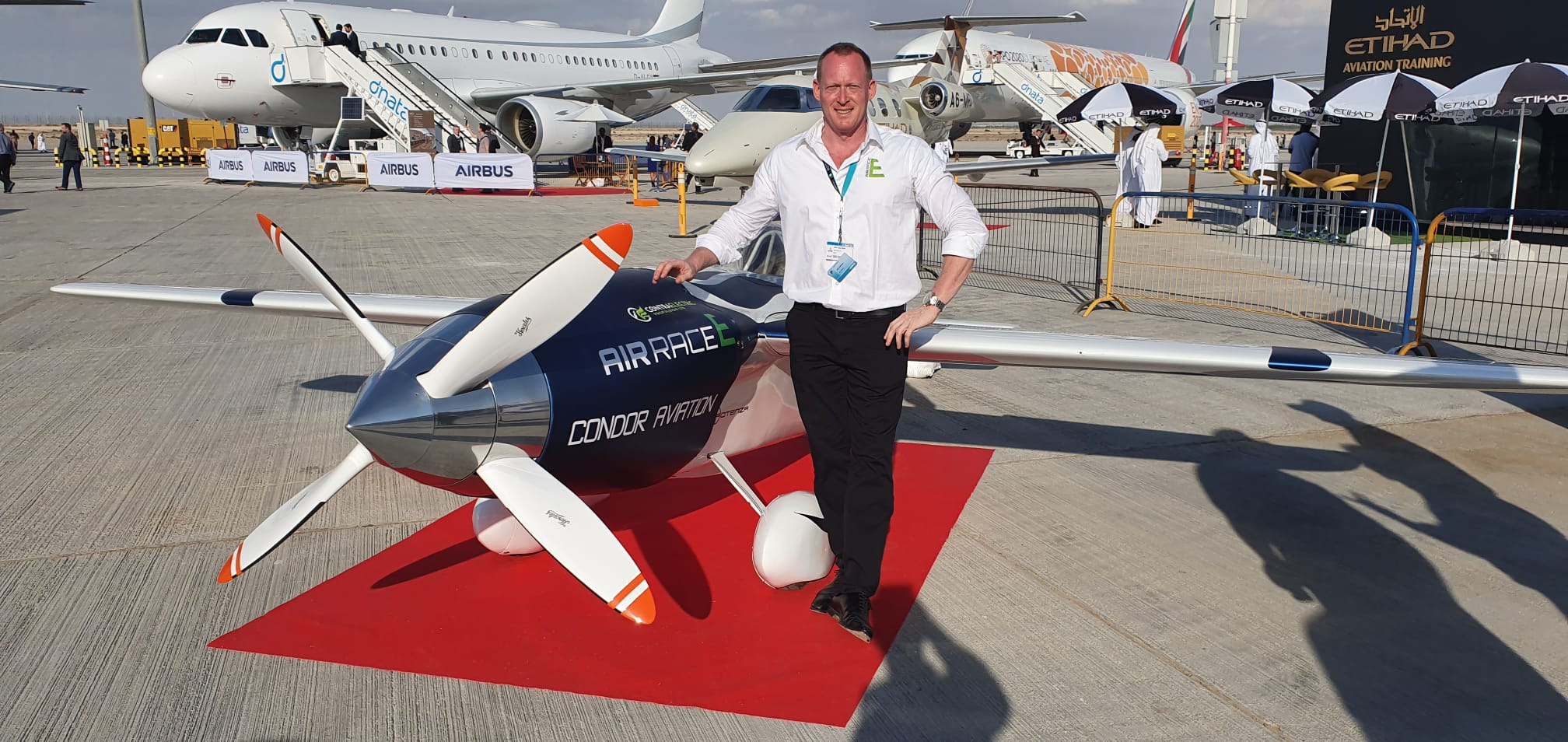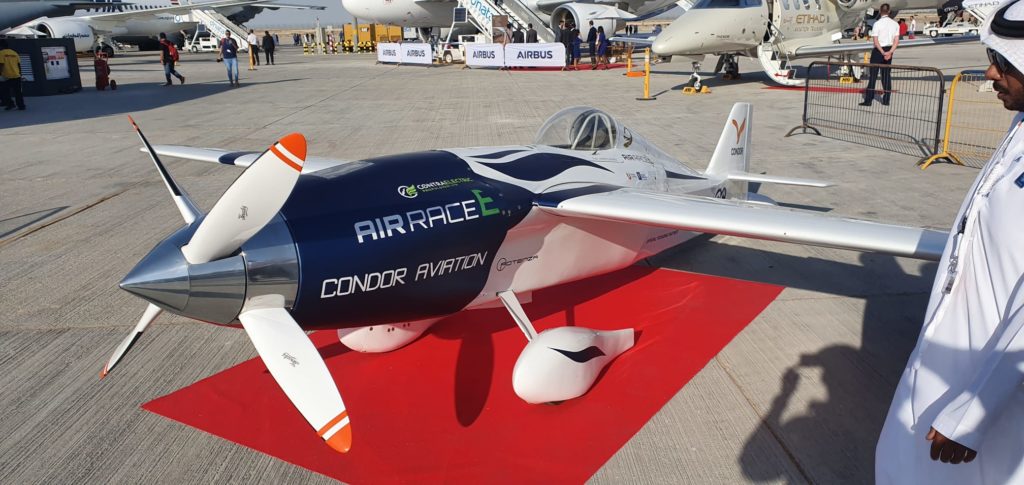Aviation
World’s first electric race plane unveiled at Dubai Airshow

Sunday 17th November, Dubai: The world’s first electric race plane has been unveiled on day one at the Dubai Airshow, showcasing custom modified technology built by one of the racing teams set to take part in the inaugural Air Race E event next year.
Air Race E, a pioneering electric air racing series headed by international air racing promoter Jeff Zaltman, made history when it revealed the plane on display at the airshow, in association with the series’ Official Founding Partner, Airbus.
Speaking at the unveiling, Air Race E CEO and Founder Jeff Zaltman said, “This is a pivotal moment not only for Air Race E, but for the aviation industry as a whole. Our aim by establishing an electric racing series is to develop a unifying platform for the development of cleaner, faster and more technologically advanced electric aircraft. The racing series will provide a testbed for innovation and accelerate the journey towards electric commercial travel. We’ve now shown it is possible and are on track to again create history when planes like the one on display at the Dubai Airshow take to the skies for the race next year.”
The E-Racer Model is the first ever example of an electric race plane, built by Team Condor in their Yorkshire-based workshop in the North of England using a highly-modified Cassutt aircraft with a rich history in formula air racing dating back to 1979.
The custom Cassutt racer named White Lightning was once a regular on the formula one racing circuit in Europe throughout the 80’s and 90’s, with owner and pilot Andrew Chadwick earning a number of podium finishes to add to White Lightning’s racing pedigree. Chadwick has since donated the aircraft to Team Condor to compete in the upcoming Air Race E series.
Team Condor leader Martyn Wiseman and his crew have spent the past months converting White Lightning into a fully-electric racing machine, utilising a Contra Electric twin motor and contra-rotating propeller powertrain.
The customised electric motor will enable the plane to race at speeds of around 300MPH. During the races, the combined max continuous power will be set at 150kW, according to the electric formula. Over 100kg worth of lithium batteries installed under the fuselage of the plane will provide power for five minutes of high intensity racing and around 10 minutes of reserve flying at reduced power.
As Official Founding Partner, Airbus providing teams, including Team Condor, with industry insight and research as they build and modify their racing aircraft.
The E-Racer model on display at the Dubai Airshow, nicknamed White Lightning, is one of two electric race planes nearest to completion, the other is being built at the University of Nottingham’s Aerospace Technology Centre in the UK as part of its £13M Propulsion Futures Beacons of Excellence research programme. Project lead Richard Glassock, a University of Nottingham engineering fellow, has also been instrumental in the development of White Lightning and expects to have his model in the air by early next year.
Air Race E will be a series of head-to-head international air races, showcasing the skills, expertise and ingenuity of the best pilots and engineers from around the world. Unlike similar racing events which operate on a time trial basis, Air Race E events will see eight planes fly simultaneously around a tight 5km circuit at just 10m above the ground and at speeds of up to 450kph – faster than any land-based motorsport.
Air Race E will announce the first eight teams to contest the inaugural race on Tuesday 19th November. The racing field includes strong representation across Europe and North America, with team leaders coming from diverse backgrounds in aerobatics, manufacturing, air racing, the military and robotics.
A tender for the first host city is underway, with the successful bid to be announced in due course. Air Race E remains open for parties to register their interest in entering or sponsoring a team or hosting a future race.
About White Lightning by Team Condor
Power: 150 kW max continuous
Battery: ~20kWh
Aircraft type: Cassutt Racer (modified)
Engine type: Fully electric
Wing span: 4.6m
Length: 4m
Weight: 375kg

Aerospace
India is set to build a central command for the Air Traffic Control system, called ISHAN

India’s air traffic growth has led to increased responsibilities for air traffic control. The Airports Authority of India (AAI) is considering centralizing air traffic control for aircraft, dividing the country into four regions. The goal is to consolidate India’s segmented airspace into a single entity to improve air traffic management (ATM) efficiency, safety, and smoothness.
Recently, the AAI invited expressions of interest to develop a detailed project report for the Indian Single Sky Harmonized Air Traffic Management (ISHAN) initiative in Nagpur. Under this plan, air traffic controllers in Nagpur would handle domestic flights flying above 25,000 feet, eliminating the need for coordination among controllers in different regions.
For domestic regional flights operating above 25,000 feet, control would shift to the central command in Nagpur. This consolidation aims to enhance airline operations, increase flight handling capacity, and reduce congestion and flight times for passengers.
Currently, the AAI provides ATM services over Indian airspace and adjoining oceanic areas, covering over 2.8 million square nautical miles. This airspace is divided into four flight information regions (FIRs) in Delhi, Mumbai, Kolkata, and Chennai, along with a sub-FIR in Guwahati.
FIRs are responsible for providing air traffic services, including weather information, visibility, and search and rescue assistance. The proposed unification under the ISHAN initiative aligns with the projected growth of the aviation industry, which anticipates a doubling of domestic passenger traffic by 2030.
Aviation
Airbus is set to increase the production rate for the A350 as demand surges

Airbus SE is set to boost production of its advanced A350 widebody jet as it capitalizes on rising demand for long-distance travel and wide-body aircraft, amidst the ongoing crisis affecting its competitor Boeing due to issues with the B737 Max.
The surge in orders for Airbus’s A350 aircraft has instilled confidence in the company, prompting them to ramp up production rates. This move is particularly advantageous as Boeing continues to grapple with production quality issues surrounding its 787 and 777x aircraft.
In 2024 alone, Airbus has received 137 orders for the A350, signaling a need to expand manufacturing capabilities to meet customer demands. With 1,277 orders received and 592 aircraft delivered as of April 2024, Airbus is poised to fulfill pending deliveries efficiently.
The European aircraft manufacturer announced plans to increase production of A350 jets to 12 per month by 2028, surpassing earlier projections aiming for 10 per month by 2026. This decision was disclosed alongside the company’s first-quarter figures.
The Asian market is proving lucrative for the A350, with significant orders from airlines like Indigo and Air India, totaling nearly 70 aircraft commitments for the future. Meanwhile, Airbus is progressing with its A220 and A320 programs, aiming for a monthly production rate of 14 and 75 aircraft, respectively, by 2026. Additionally, the long-range A321XLR is anticipated to commence service in the third quarter of the current year.
In contrast, Boeing has been compelled to scale back production due to regulatory pressures aimed at enhancing factory processes. While Airbus anticipates a positive market outlook, Boeing continues to face challenges with FAA certification and quality approvals, resulting in ongoing delays for its 737 Max and 777x models.
Financially, Boeing reported a significant cash burn of $3.9 billion in the first quarter, leaving it with $7.5 billion in cash and short-term securities by the quarter’s end, down from $16 billion at the beginning of the year. Consequently, Boeing’s stock has plummeted by 38% in the year so far, contrasting with Airbus’s 14% gain, marking Boeing’s lowest performance in over a year.
For a full listing including details on customers and regions, as well as historical data for the previous year, go to the download section below.
- March 2024 deliveries: 63 deliveries to 32 customers
- March 2024 gross orders: 137
- 2024 deliveries to date: 142 deliveries to 45 customers
| Single-Aisle | A300/A310 | A330 | A340 | A350 | A380 | TOTAL | |
|---|---|---|---|---|---|---|---|
| Total Orders | 19470 | 816 | 1774 | 377 | 1277 | 251 | 23965 |
| Total Deliveries | 11705 | 816 | 1598 | 377 | 592 | 251 | 15339 |
| Aircraft in Operation | 11007 | 271 | 1482 | 202 | 591 | 234 | 13787 |
Aviation
All passengers killed in plane crash, after pilot let his children to control the plane

When boarding a plane, passengers entrust their safety to the skilled hands of the pilot. However, tragedy struck when one of the flight ended in disaster as all passengers lost their lives in a horrific plane crash.
In 1994, during a flight from Moscow to Hong Kong, tragedy struck as an Aeroflot relief pilot made a fateful decision. In a move that would have devastating consequences, the pilot invited his own children into the cockpit to play with the controls. Little did anyone know, this seemingly innocent gesture would lead to the loss of all 75 lives aboard the aircraft.
It was a seemingly innocent act that led to catastrophic results. The relief pilot, Mr. Kudrinsky, invited his two children, Yana, 12, and Eldar, 15, into the cockpit during the late hours of the night. Little did anyone know, this simple gesture would set off a chain of events that would end in tragedy.
Once in the cockpit, the children were allowed to sit in the captain’s chair and play with the controls, unaware that they should have been disabled as the plane was in autopilot mode.
Eldar, perhaps in a moment of curiosity or innocence, held the control column down for a mere 30 seconds. Yet, in those brief moments, the autopilot disengaged, thrusting the aircraft into manual control.
By the time the pilots regained their seats and attempted to regain control, it was too late. Despite their efforts to pull the plane out of a dive, they overcorrected, causing the flight to climb almost vertically, ultimately stalling it.
Final moment Flight 593 crash
In the final moments, as the pilots struggled to stabilize the aircraft, Flight 593 crashed into the Kuznetsk Alatau Mountain range in southern Russia, completely obliterating the plane and claiming the lives of everyone on board.
Investigations revealed a chilling truth: there was no evidence of technical failure. Instead, the crash was attributed to the unthinkable decision to allow inexperienced hands to manipulate the controls of a commercial aircraft.
The black box recording captured the harrowing sequence of events, providing a grim reminder of the human cost of a lapse in judgment. In just over two minutes, the lives of all on board were tragically short, leaving behind a legacy of sorrow and unanswered questions.























